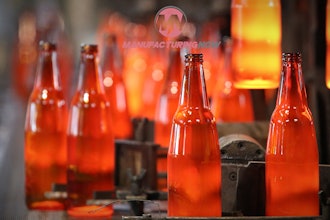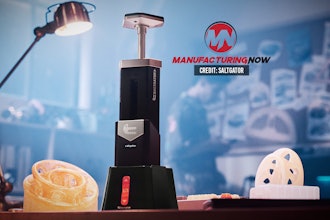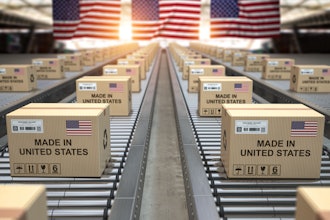Methods of manufacturing – and the manufacturing software that enable them – have changed a great deal since the Ford assembly line, shifting from the rigid, push-oriented production principles of the early 20th century to more flexible, pull principles. If you find yourself wondering what a pull principle is, you’ve come to the right place.
Put simply, assembly line manufacturers historically pushed mass production ahead based on estimates of future demand, which often resulted in wasted effort and resources when customers failed to produce the estimated demand. Modern companies can’t afford this kind of waste, so they wait for actual demand to pull production forward, manufacturing products when they’ve been requested by customers or when the previous batch of products has sold out.
Consider this analogy. By trying to guess potential demand, manufacturers often found themselves in the same situation as someone carrying an umbrella on a sunny day because the forecast predicted rain: extra effort for no reason. Modern manufacturers prefer to stick their head out the window and check for rain before grabbing their umbrella, so to speak, limiting waste and maximizing efficiency.Unfortunately, understanding the many complex strategies behind these new manufacturing methods can be as difficult as predicting the weather, as they have brought along with them a series of three-letter acronyms that dominate jargon-filled conversations about current manufacturing trends, like JIT, TPM, QRM, and JIS. These letters don’t exactly help to explain the basic ideas behind pull-production manufacturing, which actually make a lot of sense when spoken in plain English. So for the next installment in our “plain english guide” series, we’ve decided to break down the key concepts of lean manufacturing, Six Sigma and flexible manufacturing. While we couldn’t cover every concept – a Google search for “lean manufacturing glossary” should satisfy most pedants – we have reviewed the important terms. Leave a comment below if there are others you’d like us to explain. Let’s get started.
- Reduce waste - reduce the amount of materials, capacity and manpower wasted in the process by producing just enough product to meet current demand
- Maintain quality – devise more effective manufacturing methods in order to continue making quality products despite strict reductions of waste
- Accelerate production – decrease the amount of time needed to manufacture product, making up for the lack of surplus
Reduce Waste
If this first concept sounds like the motto of the recycling movement, it’s because manufacturing, like so many other industries these days, is basing its methods on efforts to avoid waste. Earlier manufacturing methods allowed for waste and an excessive consumption of supplies in order to meet their goals of mass production, but the re-branding of modern manufacturing goes by a new name: lean manufacturing.
Lean manufacturing describes the method used to achieve all three of the aforementioned concepts; in theory, a lean manufacturer would have the right supplies arrive at the right place at the right time in the right amount to create only the products that are necessary to meet demand. A number of concepts, defined below, are influential in meeting this goal.
- Just In Time (JIT) – The concept of JIT basically suggests that any inventory is waste. JIT manufacturers buy just enough supplies to keep the process moving and schedule them to arrive at the factory “just in time” for them to be used in production.
- Kanban – When supplies are running low, factories have an automatic request for new supplies sent to their suppliers. These alerts have traditionally been called Kanban, and they are now often computerized.
- Just-In-Sequence – The most extreme example of JIT. Supplies arrive at the factory at the exact moment they are needed within the manufacturing sequence, which means production may come to a standstill if the supplies are just a few minutes late.
- Total Productive Maintenance (TPM) To avoid stopping production, some factories wait until the end of the day to repair minor issues with their machines. But TPM suggests that manufacturers will benefit in the long run by repairing the machines immediately and avoiding deterioration in the future.
- Quick Response Manufacturing (QRM) – QRM is focused on making the time between a customer’s request for a product and the final delivery of that product as brief as possible.
- Cellular Manufacturing – This concept separates the factory floor into different sections (cells). Machines are placed in a certain order so that materials flow naturally toward the completion of a product.
- Single-Minute Exchange of Die (SMED) – Manufacturers are always looking to reduce wasted time, even between projects. SMED focuses on changing the factory process from working on an old product to a new product as quickly as possible.
Maintain Quality
In order to manufacture a product of consistently high quality, it’s necessary for manufacturers to not only perform frequent maintenance on their equipment, but on their entire process as well. This means identifying errors or defects in the production flow and eliminating them to maximize productivity. This is where Six Sigma comes in.
The origin of the term itself is very complex. A manufacturing process is given a sigma rating based on the percentage of its product yield determined to be defect-free. A one-sigma rating designates a process with a disastrously low percentage of defect-free yield, 31%, while a six-sigma rating is reserved for processes that are nearly perfect, 99.99966% defect-free. In other words, every company wants to achieve six sigmas for all of its manufacturing processes.
To meet this goal, the Six Sigma method was created, which focuses on measuring and analyzing process data in order to find and remove defects. Whereas lean manufacturing is concerned with improving the flow between processes to reduce waste, manufacturers use Six Sigma to improve the processes themselves.
- Define, Measure, Analyze, Improve, Control (DMAIC) – The Six Sigma methodology if focused on improving the basic manufacturing processes that are already in motion.
- Define, Measure, Analyze, Design, Verify (DMADV) -- This alternative methodology is a more anticipatory approach. Based on an analysis of customer demand, manufacturers plan ahead and try to design ways to avoid defects in the first place.
- Critical To Quality (CTQ) and Quality Function Deployment (QFD) -- These two concepts try to pinpoint the elements of a product that are most important to customers and translate those needs into a manufacturing strategy that focuses on getting the critical elements exactly right.
- Suppliers, Inputs, Process, Outputs, Customers (SIPOC) – SIPOC is a diagrammatic tool that allows manufacturers to trace the life cycle of their products from supplier to customer and identify problem areas.
- Taguchi Loss Function – If a manufacturer designs a production plan that will maximize product and efficiency, any sudden changes or variations from that plan pose a problem. The Taguchi Loss Function suggests that production quality decreases as variation increases.
Accelerate Production
In the era of lean manufacturing, when surplus product is considered waste, the manufacturing process must work faster to make sure products are made available and demand is met. However, speeding up the process has become more difficult than ever due to an increased customer desire for customization.
In the 20th century, mass production and mass consumption went hand in hand. Assembly lines made it possible to make hundreds of thousands of the same product, and customers were entirely willing to own the exact same thing as their friends and neighbors. Now, with the advent of Internet shopping and its capacity to provide shoppers with a variety of choices, manufacturers must be prepared to adapt and change not only its products but its entire process as well.
Enter flexible manufacturing. Though manufacturers would undoubtedly prefer to continue producing standardized products at low costs, they must nevertheless make the best of their customers’ new tendencies toward individualized, unique products. These manufacturers can limit their cost increases by designing processes that adjust quickly and effectively to change. This table provides a few of the concepts that allow manufacturers to remain flexible while continuing to reduce waste and maintain quality.
- Machine Flexibility – This concept refers to the capacity of a factory’s machines to adapt. Can they be changed to manufacture different products? Will they allow for slight variations in design that customization requires?
- Routing Flexibility – This concept is focused on the adaptability of the manufacturing process as a whole. Does the factory have multiple machines that can complete the same task? Can they be paired with various other machines o make customized products?
- Computer-aided Design (CAD) and Computer-aided Manufacturing (CAM) -- Computers allow customers to customize products, and they also allow manufacturers to create those products with agreeable costs. If a factory has machine and routing flexibility, they can use CAD to design production processes and CAM to guide parts though those processes with robots and computer controlled-machines (CCM).
- Computer-integrated Manufacturing (CIM) – Maybe the most important element of flexible manufacturing, CIM creates a network of computers that observe and operate the manufacturing process. With CIM, computers can monitor every step of production for defects and change the actions of a machine almost immediately, contributing to flexibility.
With customer demands shifting constantly on a global scale, manufacturers must utilize a number of strategies to maximize their profits and continue to compete. As this guide suggests, the three major goals of reducing cost, maintaining quality, and accelerating production are achieved through the combined efforts of lean manufacturing theories, Six Sigma methodologies, and flexible processes. It’s not a question of which manufacturing method is the right one, it’s a question of how to implement them all for optimum results.
For more manufacturing software advice, check out The Manufacturing Blog.


















